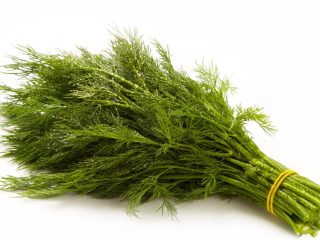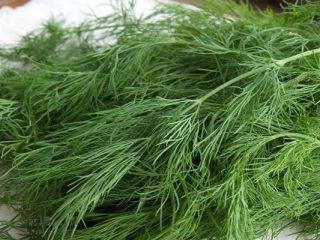Content
Dill Hercules is a delicate, aromatic variety. The volume of green mass is an indicator that distinguishes it from other varieties. Therefore, the herbaceous crop is often used for commercial purposes.
Description of the Hercules dill variety
Dill Hercules is a bush variety. Belongs to the mid-early types. Full ripening occurs 40-45 days after planting. The culture blooms on the 70th day. The plant is powerful, semi-spreading, not prone to lodging. The leaf rosette is erect. Height 20-25 cm.
The leaves are large, bright green with a slight waxy sheen. The shape is highly dissected. The aroma is strong due to the high content of essential oils. The greens are tender and taste pleasant.
Hercules is used for canning, pickling vegetables, and preparing seasonings. Perfect for growing green mass. Blooms late, can be sown throughout the summer. The bush variety is grown in open-air beds or in greenhouses.
Productivity
Dill Hercules grows quickly. It takes just over a month from sowing the seeds to harvesting the harvest. Harvest when the plant reaches 20-25 cm. When planted in open ground, the yield per 1 sq.m averages 1-1.5 kg. In greenhouse conditions, this figure is 2.5 kg per 1 sq. m. m.
The yield of Hercules dill is significantly influenced by the soil, as well as the method of cultivation. Under favorable conditions, regular watering, fertilizers, lighting and a temperature of + 18-20 ° C, you can get from 3.5 kg per 1 sq. m.
Sustainability
Dill Hercules grows poorly in the absence of precipitation. With prolonged drought, the plant turns yellow and dies. The temperature regime is no less important for an aromatic crop: critical indicators will be 5 °C and below or above + 30 °C.
The variety is not susceptible to attacks by harmful pests. Fungal diseases are rare in the plant.
Advantages and disadvantages
Dill Hercules is a productive variety. If the spring is early and warm, then gardeners can count on good results. The abundance of green mass makes this variety attractive for commercial cultivation in various volumes.
Strengths of the Hercules variety:
- marketable condition;
- endurance;
- universal application;
- rich aroma;
- resistance to diseases.
The disadvantages of dill are the short shelf life of fresh herbs.
Landing rules
It will feel ideal in light loam, cultivated sandy loam soil, and neutral black soil. Dill Hercules responds well to loose fertile soils. It does not accept acidic environments. To obtain a nutrient medium, fertilizers are applied. Norms for 1 sq. m. area:
- humus – 3 kg;
- potassium salt – 18-20g;
- superphosphate – 25 g.
An important component of high yields is the presence of sunlight. The fragrant plant should be planted in open areas.In partial shade the bushes will be smaller.
Sowing Hercules dill seeds is usually carried out in April or May. Gardeners advise repeat planting at intervals of 10-14 days. Sow in moist soil. The seeds are placed in shallow beards at a distance of 4-5 cm. The rows are 20-25 cm apart from each other. Such intervals must be made because due to dense planting, lateral branches do not form on the plants, and the internodes are stretched. Before the first seedlings appear, it is advisable to cover the bed with agrofibre.
The time when the first shoots appear ranges from 1-2 weeks, it all depends on weather conditions. After another week, the young dill must be thinned out, leaving 15-20 cm between plants.
Growing technology
Caring for the Hercules dill variety is quite simple.
- Firstly, it needs to be watered regularly, but not flooded. For 1 sq. m will require 5 liters of water. Carry out the procedure once every 2-3 days. If it's hot outside, the frequency of humidification will need to be increased.
- Secondly, timely loosening of row spacing and removal weed. The dense crust on the ground does not allow oxygen to pass through, so the plant cannot fully develop. Weeds create shade and also suck nutrients from the soil.
- Third, feeding. During the growing season, experienced gardeners recommend watering Hercules dill with potassium-phosphorus preparations.
Diseases and pests
The photo shows a healthy Hercules dill. The pests didn't like it.
But fungal diseases sometimes prevail. The plant may be disturbed by:
- powdery mildew – a white coating, similar to a cobweb, that covers the leaves;
- phomosis – oblong spots of a dark shade, appear mainly on leaves, stems and even on roots;
- blackleg – the root collar of the seedlings darkens, rots, and becomes softer;
- peronosporosis – according to the spring symptoms, the disease is similar to powdery mildew.
There is no point in fighting the dill disease. It is not recommended to use chemicals due to the use of fresh dill. It will be more effective and safer to treat seeds before planting with disinfectants. You can leave the seed in a solution of potassium permanganate for a couple of hours, or use biostimulants.
Conclusion
Dill Hercules is a bush variety. It is grown in greenhouse conditions or in open ground. The plant can withstand minor frosts. Suitable for cultivation for sale.











